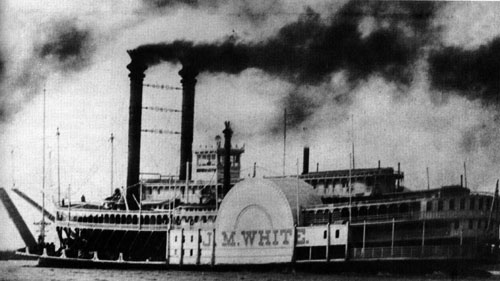 The J.M. White III on the water
The J.M. White III on the water The J.M. White III on the water
The J.M. White III on the water
Although capable of beating any other steamer, Captain Tobin refrained from challenging the record of the venerable Rob't E. Lee, still plying the waters, eight years after defeating the Natchez in a famous race. Tobin was a close friend of Captain John W. Cannon, the captain and owner of the Lee. Cannon was near retirement and still held the record for the New Orleans to St. Louis trip. Tobin decided the older Captain should retire with his record intact.
However, Captain Tobin was not friends with Captain Thomas Paul Leathers, the owner of the Natchez. Captain Leathers liked to allow boats docked at New Orleans to pull out in front of the Natchez and he would then pass the boat while under full steam. The show was well known to the people on the New Orleans wharf and never failed to impress the passengers of the Natchez. Once Leathers did this to Tobin while he was aboard another of his boats, the Ed. Richardson. Tobin vowed to get even and waited to use the J.M. White to do it.
When the time arrived to beat the Natchez using the J.M. White, the two boats pulled away from New Orleans at about the same time. The Natchez gained the lead and the duel appeared over. The J.M. White had a minor accident and slowed for repairs. After the crew finished, Tobin put her under steam, caught and passed the Natchez, and set a new speed record of seven hours between New Orleans and Baton Rogue. The J.M. White's record time broke the Rob't E. Lee's best time by more than forty minutes.
Unfortunately the J.M. White was an expensive boat to operate and Tobin faced bankruptcy after only eight years of service. Tobin tried various means to stay in business with the White but even bringing in new business partners was not enough. Insurance premiums in excess of $100,000 were more than he could afford. The final months of the White's operation were not pretty. With its owners unable to afford repairs or regular upkeep, the ship deteriorated.
On December 13, 1888, the J.M. White met with tragedy while on a routine run from Vicksburg. Apparently a careless passenger was smoking and ignited drapes. However, the reason the J.M. White burned will never be known for certain. With a full load of cargo and passengers, the ship had just tied fast to the Blue Store landing, when flames engulfed the decks. An estimated twenty-eight people died and the J.M. White was no more.